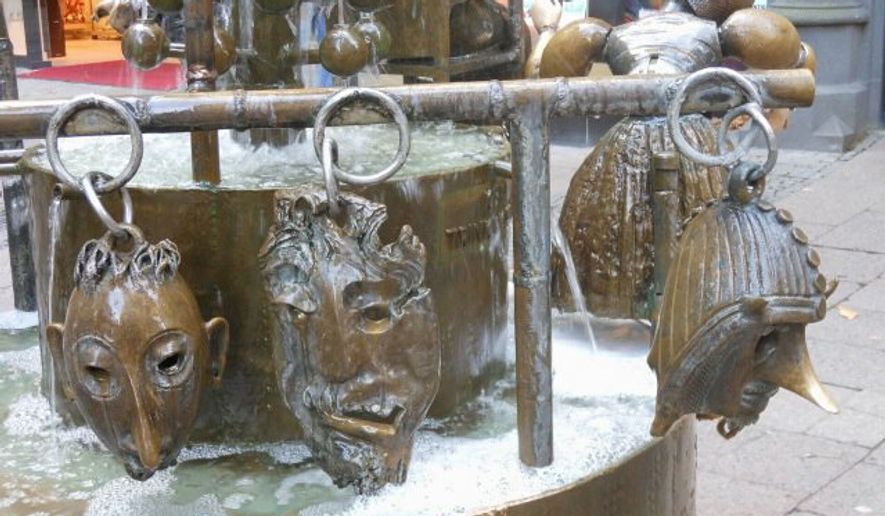When we drove from Belgium into Germany for the first time after the end of World War II, a roadside sign announced that we had arrived in the city of Aachen. We drove on until we came upon a sign announcing that we leaving Aachen. Everything between the two signs was a wasteland of rubble, a dark and bleak landscape punctuated only by the spire of a distant cathedral.
Aachen was the first city inside Germany taken by the U.S. Army, after a fierce battle over September and October 1944. Today, Aachen — called Aix la Chapelle in France — has regained its historic charm. A few half-timbered houses survived on the narrow streets of the old town, two of the old city gates still stand, and ancient buildings have been carefully reconstructed. The 30 thermal springs in the Aachen basin — said to be the hottest in central Europe — are suitable again for treating rheumatic and muscular disorders, having attracted tribes as far back as the Neolithic people, the Celts, and later the Romans, who settled here in the first century after Christ. They built two large thermal baths, and remnants survive. Today’s spas are located outside the city center.
The year 2014 is important in Aachen as the 1,200th anniversary of the death of Carolus Magnus, better known as Charlemagne, who made Aachen the center of his vast empire because he liked to soothe tired muscles in the warm mineral springs that gave the town its name. He is clearly Aachen’s favorite son.
Charlemagne was a tall, imposing figure, described by his biographer and courtier as with a “round head, large and lively eyes, a slightly larger nose than usual a bright and cheerful expression.” He had 4 wives, 11 legitimate children, 6 known concubines and 7 illegitimate children. He was king of the Franks, king of Italy, and in 800, Pope Leo III crowned him emperor of the Holy Roman Empire. He was called “the father of Europe” (and lived up to it in more ways than one), having united most of Western Europe for the first time since the fall of the Roman Empire. His empire included today’s France, Germany, the Netherlands, Belgium, Italy and northern Spain. He obviously needed those relaxing baths.
Charlemagne was, like his round head, a rounded ruler. He introduced political, economic, educational and cultural reforms, and Christianity. He even introduced a standardized script, which became modern lowercase letters, and a common currency. He built the first European school, and introduced education for girls, but he nevertheless never permitted his daughters to marry. He was a warrior king, larger than life. He is entombed in Aachen in the cathedral he built. The core of the church is an octagon surrounded by a 16-sided walkway. Charlemagne’s white marble throne sits in an upper gallery. All the kings of Germany, ending in 1531, were crowned on his throne for 600 years.
In medieval times, the city was a center of the textile industry and in the 14th century it was famous for manufacturing needles. When citizens of Aachen greet one another abroad, they wiggle the little finger of the right hand; that finger was used to test whether a newly manufactured needle was straight, and if not, it was flicked away. Aachen is more famous today for its chocolates (Lindt chocolates are manufactured in Aachen). The city, a technology and medical center, is known as well for its “printen,” or spice cookies.
PHOTOS: Charlemagne lives — and thrives — in modern Aachen
Aachen is a city of fountains. Most impressive is the 17th century Market Fountain, crowned with a statue of Charlemagne, in front of the imposing 15th century town hall, once part of Charlemagne’s palace. The Charlemagne Prize, given for outstanding service to the reunification of Europe, is awarded annually in Coronation Hall, where the kings of Germany feasted after their coronations.
The Elisa Fountain in the center of town bubbles up with sulfuric mineral water, which the locals drink with enthusiasm for its healing qualities. A particularly delightful Puppet Fountain is decorated with bronze figures relating to the history of Aachen: a bishop, farmer, peasant woman and a lawyer surround a knight on horseback, all with moving parts. In the old fish market, water gushes from a small, naked boy holding a fish in each hand. Scratches on a nearby stone wall were left by fishmongers of centuries sharpening their knives. One of the city’s oldest houses, once the city hall and now a building housing the municipal archives, is near by.
A fountain memorializes a thief who thought he had stolen a hen and was caught when the chicken, a cock, gave him away with loud crowing. This one is called the Chicken Thief Monument, naturally.
Charlemagne is remembered again with a golden bust at the Treasury, where the cross of Lothair is on display along with jeweled reliquaries and other bejeweled objects.
There’s an interesting newspaper museum in Aachen, too. A 19th century scholar who was born in Aachen, collected first and last editions of international newspapers. Two-hundrend-thousand digitized newspapers from the 17th to the 21st centuries are available for the curious.
Aachen likes to eat, and there are a number of excellent restaurants. The city is only an hour by fast trains from Brussels, forty minutes from Cologne and under three hours from Paris. There are shops at the train station with sausages, sandwiches, cake and fruit, easily packaged for a picnic on the train.




Please read our comment policy before commenting.